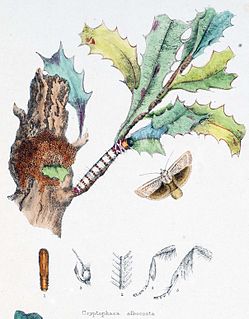Related Research Articles

Apamea crenata, known as the clouded-bordered brindle, is a moth in the Noctuidae family. It is distributed throughout the Palearctic realm.

Eudocima materna, the dot-underwing moth, is a moth of the family Erebidae found in widespread parts of the world, mainly in tropical Asia extending to New Guinea and Australia as well as in Africa. Reports from the United States, Canada and the French Antilles are now considered to be Eudocima apta. The species can be differentiated from other Eudocima moths by the presence of small central black dot in each hindwing. The species was first described by Carl Linnaeus in his 1767 12th edition of Systema Naturae.
Ethmia anthracopis is a moth in the family Depressariidae. It is found in Australia, where it has been recorded from South Australia.
Ethmia postica is a moth in the family Depressariidae. It occurs in interior areas of Australia, from north-western and south central Western Australia to western Queensland, New South Wales and Victoria.
Hypatima arignota is a moth in the family Gelechiidae. It was described by Edward Meyrick in 1916. It is found in the Indian state of Assam, Myanmar, Thailand and possibly Taiwan.
Ardozyga haemaspila is a species of moth in the family Gelechiidae. It was described by Oswald Bertram Lower in 1894. It is found in Australia, where it has been recorded from New South Wales and South Australia.
Pseudotelphusa amelanchierella is a moth of the family Gelechiidae. It is found in North America, where it has been recorded from Ohio.
Stegasta zygotoma is a moth of the family Gelechiidae. It was described by Edward Meyrick in 1917. It is found in Colombia, Ecuador, Peru and on the Galápagos Islands
Compsolechia sesamodes is a moth of the family Gelechiidae. It was described by Edward Meyrick in 1922. It is found in Brazil and Peru.
Cryptophasa ochroleuca is a moth in the family Xyloryctidae. It was described by Oswald Bertram Lower in 1892. It is found in Australia, where it has been recorded from the Australian Capital Territory, New South Wales, South Australia and Victoria.

Cryptophasa albacosta, the small fruit tree borer, is a moth in the family Xyloryctidae. It was described by John Lewin in 1805. It is found in Australia, where it has been recorded from New South Wales, Queensland, South Australia, Tasmania and Victoria.
Cryptophasa tecta is a moth in the family Xyloryctidae. It was described by Thomas Pennington Lucas in 1894. It is found in Australia, where it has been recorded from the Northern Territory and Queensland.
Cryptophasa molaris is a moth in the family Xyloryctidae. It was described by Thomas Pennington Lucas in 1900. It is found in Australia, where it has been recorded from New South Wales and Queensland.
Illidgea epigramma is a moth in the family Xyloryctidae. It was described by Edward Meyrick in 1890. It is found in Australia, where it has been recorded from the Australian Capital Territory, New South Wales, Queensland and South Australia.

Lichenaula appropinquans is a moth in the family Xyloryctidae. It was described by Thomas Pennington Lucas in 1901. It is found in Australia, where it has been recorded from New South Wales and Queensland.
Lichenaula circumsignata is a moth in the family Xyloryctidae. It was described by Thomas Pennington Lucas in 1900. It is found in Australia, where it has been recorded from Queensland.
Paralecta tinctoria is a moth in the family Xyloryctidae. It was described by Thomas Pennington Lucas in 1894. It is found in Australia, where it has been recorded from Queensland.
Lichenaula provisa is a moth in the family Xyloryctidae. It was described by Thomas Pennington Lucas in 1900. It is found in Australia, where it has been recorded from Queensland.
Agriophara velitata is a moth in the family Depressariidae. It was described by Thomas Pennington Lucas in 1900. It is found in Australia, where it has been recorded from Queensland.
Chlamydastis plocogramma is a moth in the family Depressariidae. It was described by Edward Meyrick in 1915. It is found in the Guianas, Colombia and Brazil.
References
- ↑ Savela, Markku (12 December 2013). "Arignota stercorata (Lucas, 1894)". Lepidoptera and Some Other Life Forms. Retrieved 13 July 2020.
- ↑ McMillan, Ian (11 October 2010). "Arignota Turner, 1898". Xyloryctine Moths of Australia. Retrieved 13 July 2020.
| This article on a moth of the family Xyloryctidae is a stub. You can help Wikipedia by expanding it. |